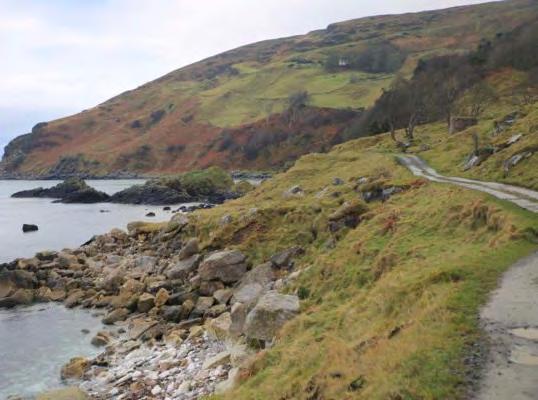
13 minute read
HISTORY AND MYTH BLURRED ON THE ROUTE OF THE GIANT’S CAUSEWAY
Coast Sportive
Part One
Advertisement
Everybody has a preconceived image of the world-renowned Giant’s Causeway, people just simply pontificate about the geological and mystical presence of this bizarre collection of rocks on the North coast of Northern Ireland, and rightly so.
We were here to experience the popular Giant’s Causeway Coast Sportive which takes place annually in June. It’s an unique event based on the iconic North Coast of Ireland offering an unforgettable cycling experience through some of the most breathtaking landscapes. This leisure event is one of the biggest road cycling events in Northern Ireland attracting over 1,100 participants to last year’s event.
The entry fee is £40 and this year’s event will take place on Saturday 22nd June 2019, cyclists have the choice of 4 routes (35 miles; 60 miles; 85 miles; 115 miles) which all start and finish in the small rural seaside town of Ballycastle in County Antrim.
After flying to Belfast International, we picked up a car and bike provided by Decathlon (organised by Outdoor Recreation NI). The robust B’twin 520 Triban looked the part and thankfully with car hire sorted and bike carefully deposited we set off in search of our base, Ballycastle.
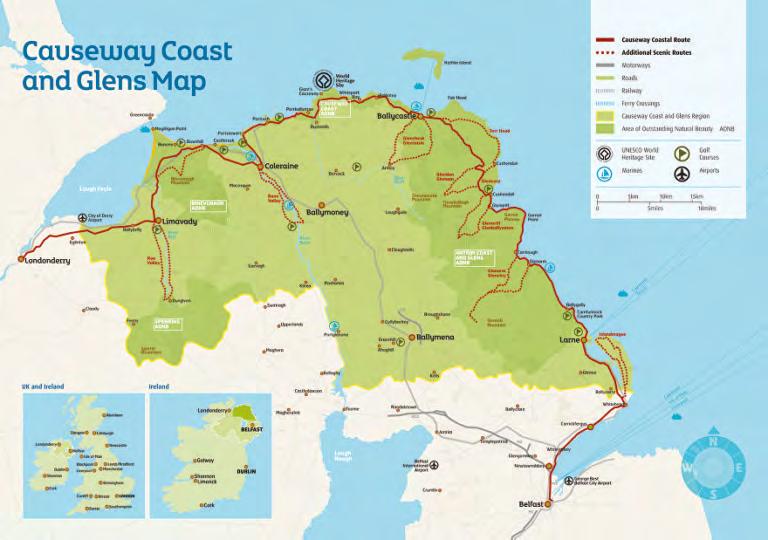
drive we arrived in darkness, our accommodation was in a prime location, close to the amenities and the sea. At the door, we were welcomed by the owners of The An Caiselan Guest House (Quay Road, Ballycastle; 028 2076 2845) Berkley and his wife have owned the building or part of the building since 1997. In total there are 17 rooms across three separate properties, once inside the vast expanse was a surprise. Our room was spacious, clean and comfy and keeps an eye on its past and one definitely on its future.
Our first task was venture out to eat, the town centre was only a short walk away. A reservation had been made at the cosy, friendly Cellar Restaurant (11b, The Diamond, Ballycastle; 028 2076 3037) centrally located in the diamond. From the street it looks far from alluring, but once inside all our senses were overwhelmed. Generous portions of local simple fare served in intimate surroundings and put together in a faultless contemporary fashion.
The next morning after a delicious Irish breakfast, my first task as I left Ballycastle was to climb, the route is well signed. As I ascended, the tops of the grey mundane buildings were replaced by a magnificent azure horizon and sweeping vertiginous landscapes. The coastline of any country is always one of the most evocative locations that any place can be rightly proud of, and the Giant’s Causeway route doesn’t disappoint. The pure Atlantic air is enough to give even the flabby and fatigued an invigorating boost, happiness and clarity will dominate your psyche.
As we get older, we stop trying new things because the stakes are too high. We worry about failure and the risk of humiliation, but I find this is not the case with cycling. I like many others continue to return to the roads/trails because its fun, healthy and completely magical when we get it right, and the Giant’s Causeway route is a perfect example of everything that is seductive and right about life on two wheels.
I had opted to follow the 60 mile “Across the Coast and Glens” route which leaves Ballycastle east along the coast, the roads were quiet and my cadence was a surprising success. I halted briefly by the entrance to the Rope Bridge at Carrick-a-Rede (119a Whitepark Rd, Ballintoy, Ballycastle) All the locals rave about this dramatic structure which is owned by the National Trust and was first erected by salmon fishermen in 1755. Connected to the cliffs by a rope bridge across the Atlantic Ocean, Carrick-a-Rede Island (home to a single building – a fisherman’s cottage) is the final destination. Suspended almost 100 ft (30 m) above sea level, it’s amazing that the bridge is over 350 years old.
There is plenty of bike parking, however the 1km walk from entrance to attraction is not suitable for a bike, or so they tell me.
As I continued my concentration was distracted by a constant crescendo of angry white water teasing the shoreline. I sensed I was being watched, okay the steep luscious hillsides have no discernible peepers but I felt my every pedal stroke was being pawed over.
I was exposed to a plethora of breathtaking panoramic views, one of the best was of White Park Bay, the bay is guarded at one end by Gid Point and Long Gilbert at the other. The blonde expanse of the beach was completely deserted, the sea was a glorious inviting blue. Dunseverick Castle is only a few miles from the Giant’s Causeway, its slightly desolate image, is in fact its great attraction. The location is surreal set amongst a collection of bungalows and I stood, completely engrossed in the simple surroundings. It a was a wonderful discovery.
It was only a short pedal from the Castle to the Giant’s Causeway (44 Causeway Rd, Bushmills) The car park was overflowing with a mass of coaches, mini-buses and cars – no sign of any other bikes. The visitors centre was heaving with plenty of camera happy tourists, the queues were lengthy and would impact on the overall experience. Our advice is obvious by we recommended you visit between 9am and 11am. or wait until after 4pm, to avoid the crowds
Flanked by the wild North Atlantic Ocean and a landscape of dramatic cliffs, for centuries the Giant’s Causeway has inspired artists, stirred scientific debate and captured the imagination of all who see it. The geological wonder consists of an area of about 40,000 interlocking basalt columns, the result of an ancient volcanic fissure eruption.
From the Causeway, I headed inland towards Bushmills (yes Bushmills is a town and not just a brand of whiskey). Before no time I had arrived. Bushmills is a normal rural town but with one worldwide attraction, the Old Bushmills Distillery (2 Distillery Rd, Bushmills) The visitors centre is well presented, a tour costs £8 for an adult. The factory is the only distillers of the drink in the world, the tour takes you through all the processes in the production of the much sort after beverage. The acquisition of the malt, the fermentation, the distilling and then the bottling processes are delivered in a wonderful way so that all can understand.
In part two we head inland and immerse in the world of ‘Game of Thrones’
Useful Information
Facilities
Refreshments Ballycastle, Ballintoy, Giant’s Causeway and Bushmills.

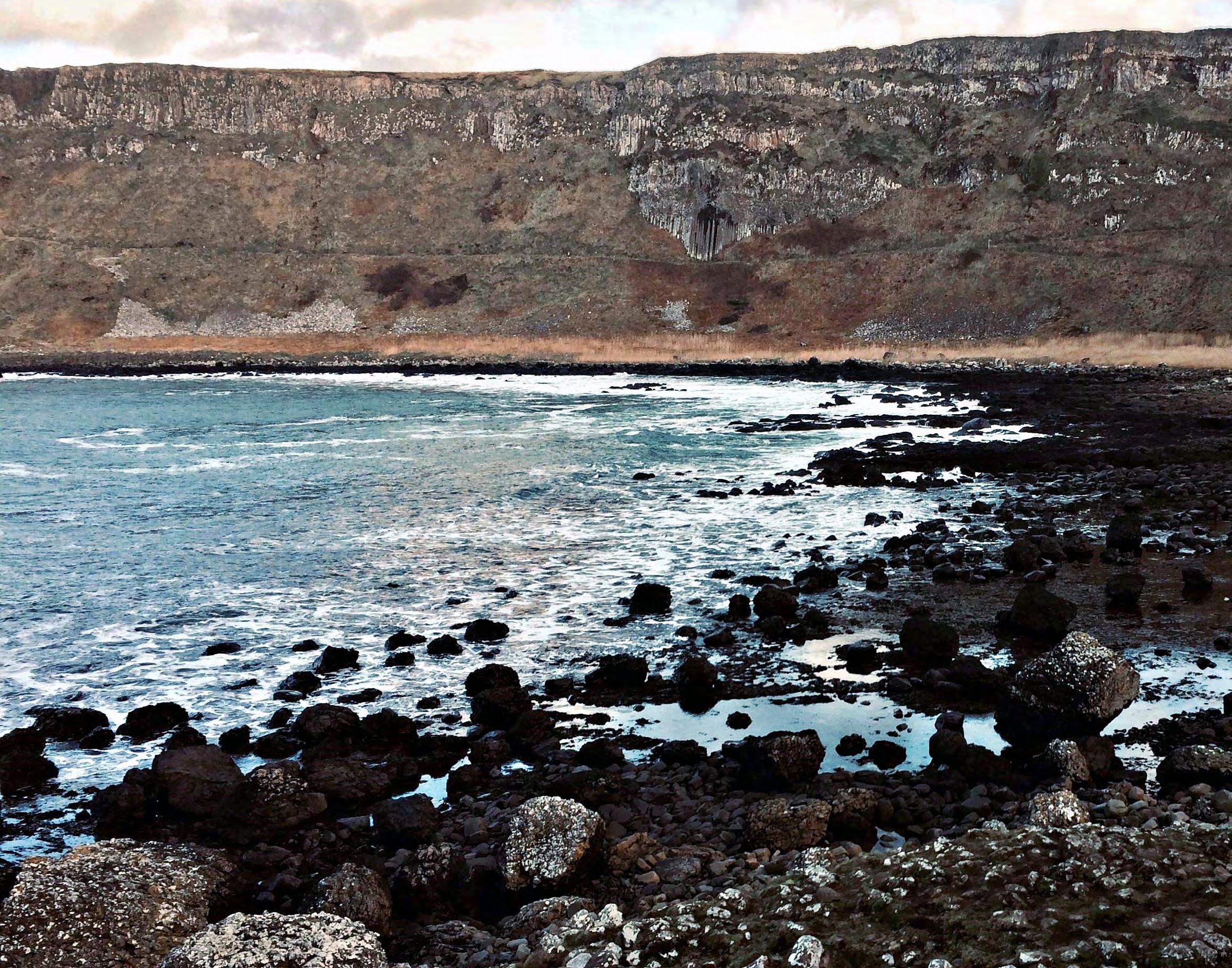

Information for people with a disability
Contact Ballycastle TIC or The Giant’s Causeway Visitors Centre TIC for opening times.
Available Publications
The Causeway Coast & Glens your guide to cycling, Ballycastle TIC Tel: (028) 2076 2024 Giants Causeway Visitors Centre Tel: (028) 2063 1855
Getting there

Belfast International (belfastairport. com) is 19 miles from the city centre, and George Best Belfast City Airport (belfastcityairport.com) is three miles, with regular shuttle buses from both. Stena Line (08447 70 70 70; stenaline.co.uk) sails between Belfast and Cairnryan, and P&O (0800 130 0030; poferries.com) from Cairnryan to Larne.
The bus station is on Station Rd, just east of the Diamond. Bus 217 links Ballycastle with Ballymena (£6.70, 50 minutes, hourly Monday to Friday, five Saturday), where you can connect to Belfast.
Bus 172 goes along the coast to Coleraine (£6.50, one hour, eight daily Monday to Friday, three Saturday and Sunday) via Ballintoy, the Giant’s Causeway and Bushmills.
The seasonal Antrim Coaster bus also stops here.
High-speed passenger ferries with Kintyre Express link Ballycastle with Campbeltown, Scotland (one-way/ return £45/80, 1½ hours, one daily June to September). A separate one-hour service runs to Port Ellen on Islay, Scotland (one-way/return £60/95, one hour, one daily June to September).
The bike

This Triban RC 520 road bike featuring Shimano’s 105 groupset and TRP Hydro disc brakes has been designed with comfort and performance in mind. It’s aimed at road cyclists who like to push that bit harder than the pack, as well as regular commuters. The frame and forks have a new geometry to enhance rider enjoyment, allowing you to ride further and more often.
Some information on the Giant’s Causeway Coast Sportive
Route 1 (35 miles / 56km)
The Causeway Coaster, 56km route, is a perfect entry level route for those who are new to the sportive scene or who are keen to soak up the Causeway Coast’s spectacular scenery. Starting in Ballycastle the route heads west towards Bushmills via the Coast Road. This circular route is mostly on flat terrain with some hills but is still classed as a challenge with some pre training definitely required. With a feed station located just after half way in, your energy will be kept up to enjoy the stunning inland scenery back to Ballycastle.
NEW! Route 2 (60 miles / 96km)
The brand new 60 mile “Across the Coast and Glens” Route is ideal for cyclists wanting to step up from the 35 mile route and take in more of the stunning north coast scenery. The route follows the 35 mile and 115 mile beginning, going west towards Bushmills via the Coast Road. Taking in the Dark Hedges, it goes on to cross the magical Glens of Antrim to Glenarm after turning at Armoy and following the 85 mile and 115 mile route in the direction of Cushendall. Here, riders will head north towards Cushendun, where that epic decision awaits you; turn left for the Torr Head bypass and reach Ballycastle after 20km with one long steady climb to finish OR Turn right and the infamous Torr Head Road awaits you. With some epic climbs and hair-raising descents, this option should not be taken lightly.
Route 3 (85 miles /134km)
*With Route Option to bypass Torr Head*
The Glens and Coast Route features the breathtaking rugged coastline and the romantic landscape of the glens. This route is geared towards cyclists who are used to pounding out 80-100km routes on a regular basis. The route begins with a steady climb through the magical Glens of Antrim to Glenarm before heading north along the world famous Antrim coast road. At Cushendun, cyclists have a BIG
decision to make. As with the 60 mile route, if you turn left you’ll face a long steady climb taking you back into Ballycastle. Or, if you turn right you’ll face the challenge of tackling the epic Torr Head. Full respect to any rider who gives Torr Head a bash!
Route 4 (115 miles / 187km)
The 187km Giant Killer offers cyclists the chance to cycle through an area of unsurpassed beauty. It is definitely classed as the BIG one and is not for the faint-hearted but for serious cyclists up for a lung-busting challenge. The route starts off by heading west towards Bushmills, along the Coast Road before tackling some reasonably tough, long climbs through the Glens of Antrim. At Glenarm the route follows the coast road all the way back to Ballycastle including the Torr Head Road which is sure to push cyclists of every level right to the limit. Expect to be rewarded with the best scenery on offer along the North Coast of Northern Ireland. Make no mistake this will be a tough day in the saddle with some serious climbs and thrilling descents but for all who complete this challenge it will certainly be a day to remember
Part Two
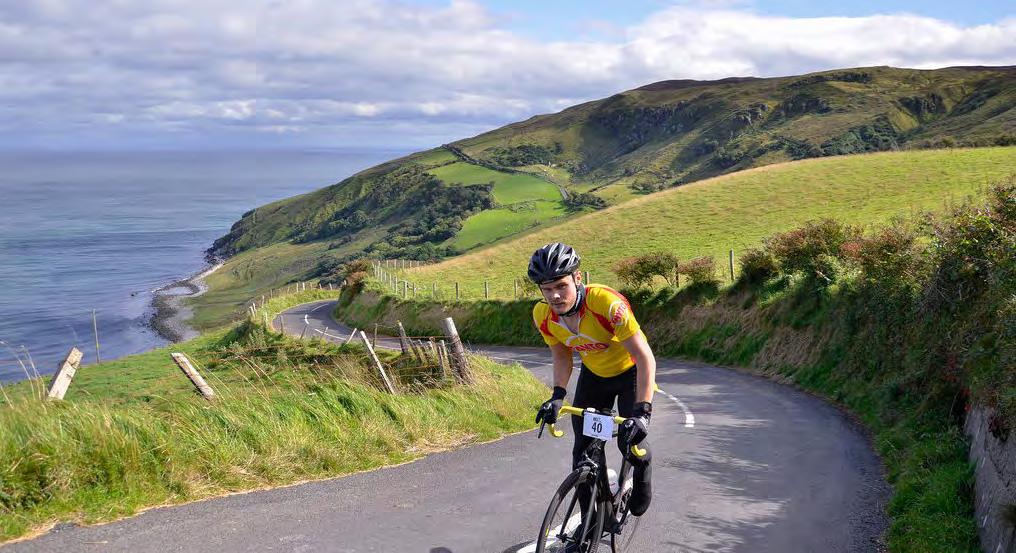
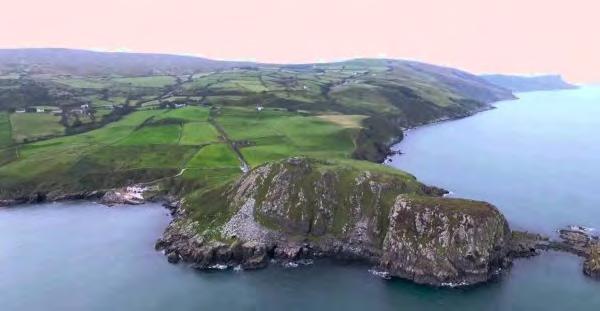
known to the discerning ‘Game of Thrones’ fanbase. The brand new 60 mile “Across the Coast and Glens” Route is ideal for cyclists wanting to step up from the 35 mile route and take in more of the stunning north coast scenery. I left the ocean views behind as pushed on at pace towards the magical Glens of Antrim. The landscape changed to a more barren, more desolate environment. The horizon dominated by slightly noisy sheep and not much else.
I was now completely engrossed in the tranquillity and after a sedate 10 miles I arrived at the otherworldly Dark Hedges. This beautiful avenue of beech trees was planted by the Stuart family in the eighteenth century. It was
intended as a compelling landscape feature to impress visitors as they approached the entrance to their Georgian mansion, Gracehill House. Two centuries later, the trees remain a magnificent sight and have become one of the most photographed natural phenomena in Northern Ireland. In fact, the iconic trees have been used as a filming location in HBO’s epic series Game of Thrones®, representing the Kingsroad.
In 2017 efforts to protect the trees were put in place and this section of Bregagh Road is now closed to vehicular traffic (with the exception of local landowners, emergency vehicles, and the like). So visitors are no longer allowed to drive through the Dark Hedges or park at the south end of the road as they were in the past. This only adds to the majesty of the surroundings, however no need to fear, there are coach/car parking and toilet facilities available at the Hedges Hotel – a two minute walk away.
I sat and recalled an article I had read over breakfast about a local ghost story featuring the grey lady, a spectre that glides along the Bregagh Road, sashaying between the gnarled trees. She vanishes from sight when she passes the last tree. Whilst some local people believe she is the ghost of a maid from the nearby house who died

in mysterious circumstances centuries ago, or perhaps the daughter of James Stuart, referred to in some genealogy lists as ‘Cross Peggy’, others believe that she is a lost spirit from an old, deserted graveyard that is thought to lie hidden in the fields nearby. On Halloween night, the forgotten graves are said to open and the Grey Lady is joined on her walk by the tormented souls of those who were buried beside her.
As an eerie mist descended I thought it best to move on eastwards towards Armoy. I was now following the 85 mile and 115 mile route in the direction of Cushendall. Here, riders will head north towards Cushendun, where that epic decision awaits the riders; turn left for the Torr Head bypass and reach Ballycastle after 20km with one long steady climb to finish OR Turn right and the infamous Torr Head Road awaits you. With some epic climbs and hair-raising descents, this option should not be taken lightly.
Next stop was Cushendun, what can I say about Cushendun? It was nice enough but not exceptional, I stopped, chatted to several locals before pushing northwards along the dramatic coastline towards Torr Head, as I climbed, visibility was deteriorating, there were occasions when I felt I was completely pedalling into the unknown. As I continued to climb, the hillside sketched out before me, before I arrived at the giddy heights of Torr Head. There was a mystical stillness in the air, the views of the Mull of Kintyre are usually superb but the mist was misbehaving. This headland was important in the 1800s for recording the passage of transatlantic ships, relaying the information back to Lloyds of London. My concentration was distracted by the waves crashing over the rocks beneath me. The ride back to Ballycastle was relatively easy, the mist finally started to disperse allowing a beautiful vista of the coastline.
Expect to be rewarded with the best scenery on offer along the North Coast of Northern Ireland. Make no mistake this will be a tough day in the saddle with some serious climbs and thrilling descents but for all who complete this challenge it will certainly be a day to remember.
